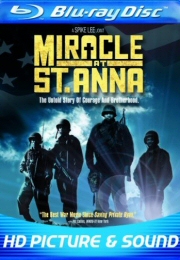 With the temperature dropping, it's time to find someone to keep you warm. Find your hookups with our online dating guide!
With the temperature dropping, it's time to find someone to keep you warm. Find your hookups with our online dating guide!
- Rated R
- Drama
- 2008
- Buy the Blu-ray
All photos © Walt Disney
Reviewed by Jason Zingale
()
t’s hard to imagine that someone as accomplished as Spike Lee could ever have a problem financing a film (especially after the critical and commercial success of “Inside Man”), but after sitting through his torturously long WWII drama, “Miracle at St. Anna,” it’s easy to see why he had as much trouble as he did. Running nearly three hours long and featuring some of the worst acting of the year, “Miracle at St. Anna” is a disastrous attempt at memorializing the black soldiers who fought in the war. If Lee injected even a tenth of the energy that went into his recent attack on Clint Eastwood into the film itself, things might have been different, but as it stands, “Miracle at St. Anna” will go down as one of this year's biggest disappointments.
The movie opens in 1980 Brooklyn where veteran postal worker Hector Negron (Laz Alonso) has just shot a man in the chest with a German Luger. The detective (John Turturro) on the scene has no leads as to why Negron would commit the murder, but when an eager young reporter (Joseph Gordon-Levitt) asks for his help, he sends him along with a couple of cops to investigate Negron’s apartment. It’s there that they discover an ancient Italian artifact (a valuable statue head that’s been missing for almost 40 years) packed away in his closet, and when the reporter asks Negron how he could possibly own such an object, all Negron can do is mumble something about a Sleeping Man.
From there, the film launches into a flashback about the 92nd Infantry Division (AKA the Buffalo Soldiers), an all-black squadron of the U.S. Army (of which Negron was a member) stationed in Tuscany, Italy. When most of his unit is decimated by a surprise attack while attempting to cross the Ando River, Negron and three other survivors – Staff Sgt. Aubrey Stamps (Derek Luke), Sgt. Bishop Cummings (Michael Ealy) and Pfc. Sam Train (Omar Benson Miller) – manage to sneak past enemy lines and hide out in a nearby village. Joining them on their adventure is a quiet Italian boy (Matteo Sciabordi) whom Train saved during the attack, but when they become entangled in a plot involving a group of Italian resistance fighters trying to smoke out a traitor from the same village, their lives are changed forever.
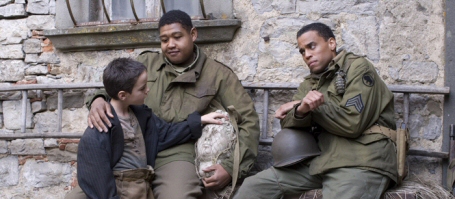
For every bit as interesting as “Miracle at St. Anna” sounds, Lee sure doesn’t waste any time in draining the life out of it. The film moves at a snail’s pace – as if there’s no particular rush to progress the story – and by the time the final act arrives, you’re so sick of waiting for something to happen that it only makes the Mickey Mouse ending appear that more absurd. Writer James McBride, who's so in love with his novel that he wouldn't dare cut a single subplot from the screen adaptation, deserves to shoulder some of the blame, but it’s ultimately Lee’s responsibility as a director to decide what belongs and what doesn’t. It takes him 160 minutes to accomplish what any other director could have done in a fraction of that time, and though some of the minor subplots may have enriched the novel, here they only bog down an otherwise simple story about why this man committed murder.
If that isn’t enough to cause a headache, then Lee’s stereotypical characters will be. I mean, if he’s so damned concerned about properly representing his fellow African-Americans, than why in the world would he include characters that only seem to confirm certain stereotypes? Clint Eastwood might have been wrong not to include black soldiers in “Flags of Our Fathers,” but at least his film wasn’t so biased. In “Miracle at St. Anna,” everyone’s a bad guy (white Americans, Germans, Italians) except for the black soldiers, who can do no wrong. You’d think that after making a movie like “Inside Man,” Spike Lee had grown as a filmmaker, but the only difference between “Miracle at St. Anna” and his earlier is work is that this racism-obsessed picture would have been better off being made by anyone other than him.
Single-Disc Blu-Ray Review:
It’s not at all surprising that “Miracle at St. Anna” is so light on bonus material. Disney was already pretty hesitant about investing in the movie, and when it tanked at the box office, they probably didn’t want to waste any more money producing an elaborate collection of extras. History buffs will still enjoy the ones that have been included, including a roundtable with director Spike Lee, writer James McBride and a group of WWII vets, as well as a short documentary about “The Buffalo Soldier Experience.” Rounding out the set are some deleted scenes, but there’s nothing here that would have made the film any less disastrous had they been included.
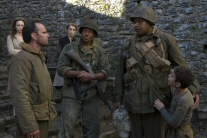 |
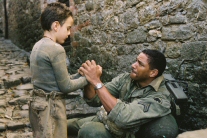 |
 |
 |
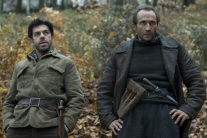 |
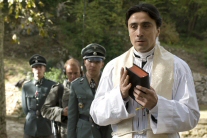 |
You can follow us on Twitter and Facebook for content updates. Also, sign up for our email list for weekly updates and check us out on Google+ as well.











